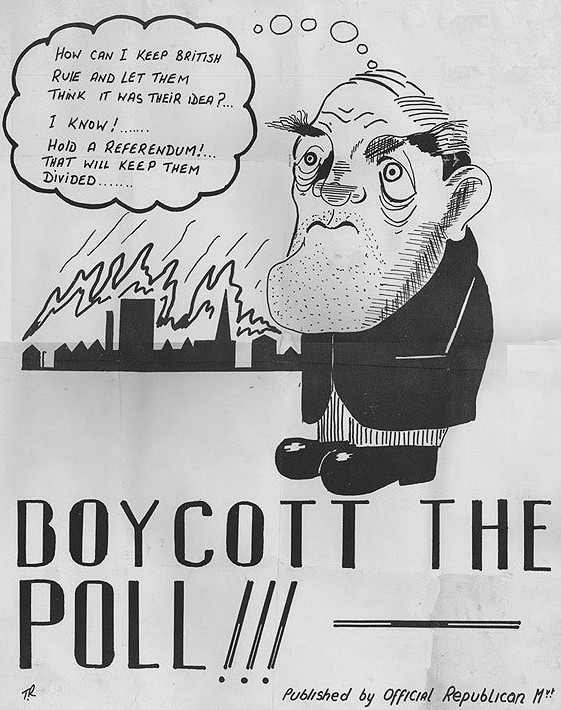Announced 45 years ago today, the result of the 1973 Northern Ireland Border Poll showed a remarkable 98.9% of voters wanting Northern Ireland to remain part of the UK, while just 1.1% wanted it to unite with the Republic of Ireland in the south.
The problem with the result was that the vast majority of Northern Ireland’s Roman Catholics had boycotted the previous day’s poll, with less than 1% thought to have cast their vote. The overall turnout was 58.66% of the province’s 1,030,084 registered voters.
 The Social Democratic and Labour Party (SDLP), which backed unification with the south, had called for a boycott of the referendum, urging its members and supporters “to ignore completely the referendum and reject this extremely irresponsible decision by the British Government”. SDLP leader Gerry Fitt said he organised the boycott to stop an escalation in violence.
The Social Democratic and Labour Party (SDLP), which backed unification with the south, had called for a boycott of the referendum, urging its members and supporters “to ignore completely the referendum and reject this extremely irresponsible decision by the British Government”. SDLP leader Gerry Fitt said he organised the boycott to stop an escalation in violence.
The Unionist parties, which backed remaining part of the UK, claimed the real reason for the boycott was that the SDLP knew it would lose even if all its supporters voted. By organising the boycott, they could at least claim the result was invalid when it failed to go their way.
It was the first time that a major referendum had been held in any region of the UK, but its critics claimed the UK government had only called it because it was confident of the outcome and could use it to justify continued control of Northern Ireland’s affairs. Not surprisingly, the landslide result was welcomed by the Unionists and derided by the SDLP.
Ulster Unionist leader Brian Faulkner said: “This is the first time ever that the people of Northern Ireland through the ballot box have quite simply and democratically stated their constitutional wishes. They have said so clearly today they are determined to stay within the United Kingdom so this removes any argument about our constitutional position from the lips of politicians for good and all, not just for five or ten years.”
SDLP leader Gerry Fitt said the result was “entirely predictable”, but even then seemed to cast doubt on the authenticity of the polling figures announced by the UK government in London. He told reporters: “I think on the figures I have just seen, which have just arrived from London, there has been massive impersonation of votes by the unionist party.”
The Government’s Northern Ireland Secretary, William Whitelaw, shrugged off any suggestion that the poll results were inaccurate. He instead told reporters that everyone in Northern Ireland who was eligible to vote had been given the opportunity to do so and it was up to individuals to decide whether or not to exercise that right.
Because of the controversy over the poll, there was a danger that polling day would be marked by violence. The authorities prepared accordingly, with extra security measures and personnel drafted in, and extensive searches of all the polling stations. In fact, polling day went relatively smoothly across Northern Ireland, but it was a different story in London, where four car bombs were planted. Two of them went off and a number of people were later arrested, with the Provisional IRA claiming responsibility.
Following the poll result a government White Paper was published which proposed setting up a devolved power-sharing assembly in Northern Ireland. It met for the first time on July 31st, 1973, but lasted only a few months before it collapsed and direct rule from London was re-imposed. It remained in force until a new Northern Ireland Assembly was established as part of the Good Friday Agreement in 1998.
Despite an end to the three decades of violence known as “The Troubles”, the question of whether Northern Ireland should remain part of the UK or unite with the Republic of Ireland remains a contentious one, especially since the June 2016 ‘Brexit’ vote.
